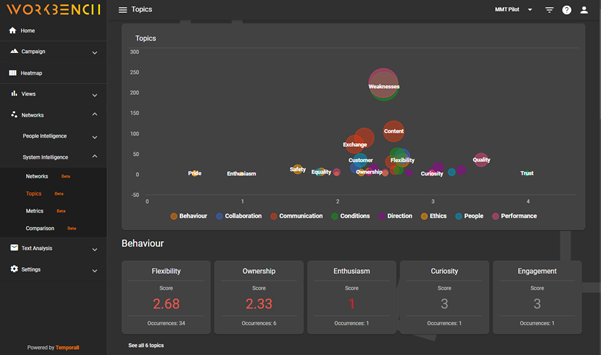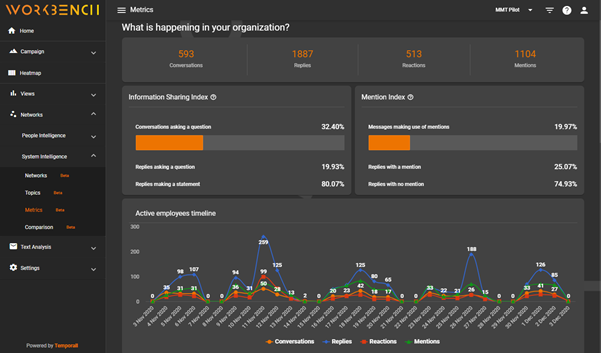Although commonly used by software engineering teams for many years, the adoption of communication tools such as Slack and Microsoft Teams across the wider organisation was rapidly accelerated in 2020 to combat disconnection within distributed workforces. With our Agile Maturity Index (AMI), organisations can, for the first time, unlock crucial insights from these communication tools with the addition of new Systems Intelligence features.
The release of this new functionality to Temporall’s organisational insights platform, Workbench, which powers the AMI, means that we can now understand how these critical agile communication tools are impacting a business and how improvements can be made to the culture, behaviours and efficacy of teams. For many companies, this untapped insight can also help drive a business case for wider adoption of these types of tools as part of an agile transformation.
The AMI provides quantitative data and sentiment from a structured survey that is focused across five key pillars of agility; high-performing teams, process & governance, technology, organisational agility and culture of innovation. The addition of Systems Intelligence, which automatically draws insight from Slack or Microsoft Teams, means it can now also:
ANALYSE HOW INDIVIDUALS ARE CONNECTED AND INFLUENCING EACH OTHER ACROSS TEAMS, DEPARTMENTS, OR ROLES
Combining this with the Organisational Network Analysis from the AMI allows leadership to locate silos of communication along with the individuals holding them together, to then create plans to reduce the risks created by these brittle communication structures.

ANALYSE TRENDS IN SENTIMENT ACROSS A BROAD RANGE OF TOPICS AND THEMES
From collaboration and ethics to people and performance, we can start to build up specific agile dictionaries to enable the AI-based system to track sentiment around quality processes or agile working practices. We can locate differences or correlations between what teams are saying in structured surveys and what they seem to be saying in unstructured conversations.

USE ADVANCED MICROSOFT TEAMS AND SLACK ANALYTICS TO UNDERSTAND HOW THE TOOLS ARE BEING USED
Organisations that use both Teams and Slack can, for the first time, compare the engagement between those platforms and look at trends in engagement across different departments, teams and channels.

These incredibly powerful tools provide some fantastic opportunities to further improve an organisation’s agile transformation and drive a positive agile culture across a large-scale engineering team that can be measured and enhanced.
However, what is exciting about these tools is the impact that they could have when rolled out more broadly across an organisation. Systems Intelligence requires these systems to be in place and being used in the first place. Whilst that doesn’t always start within the technical side of an organisation, it’s certainly very common.
In fact, it’s well known that Slack started life as the internal communications tool for the development teams of a start-up building a (not very successful!) game.
WHAT THE WIDER ORGANISATION CAN LEARN FROM SOFTWARE ENGINEERING TEAMS FOR AN AGILE TRANSFORMATION
So why are software engineering teams the seed for these types of communication tools and why might the wider organisation want to adopt them? Part of that is to do with the journey that software engineering has been on over the last few decades.
Iterative software engineering goes all the way back to the 1950’s but most people will be familiar with the shift over the last 15 years in the way that new software is released. In the 90s and early 2000s, it was the norm for a new version of Windows or Microsoft Office to be released every few years.
Now we hear stories of tech start-ups releasing multiple times a day to their live environments and companies like Microsoft have followed suit. This is also a key aim for most digital transformation projects at legacy businesses, with a move away from efficiently building a set of features, towards speed to market and efficacy of output.
It has long been discussed that organisations need to adopt this same cultural change mindset more widely, moving away from a focus on the efficient operation of departmental silos and towards a focus on a company’s value stream to customers and overall efficacy of output.
The late, great Peter Druker put it most elegantly when he said: “There is surely nothing quite so useless as doing with great efficiency what should not be done at all.”
A crucial change which enabled engineering teams to move towards this more iterative, agile way of working was the breaking down of silos and a change in the way they communicated. In the traditional waterfall method, the silos were not organisational departments but different units in the engineering capability.
UX and designers passed the vision across while business analysts and architects planned it out and passed it to the development teams. Web developers then built the whole solution and passed it to the testers who did all the quality assurance before finally handing it the release teams.
The core concept of agile engineering is to bring all of these roles together into one high-performing team.
Whilst there may be some additional challenges, the same can be done across an entire organisation. It is not the case that the departments do not need to exist as this internal structure is crucial for line management and career progression.
However cross-departmental, high-performing teams focussed on delivering value can still be formed, with tools such as Teams and Slack helping to drive this.
As these new systems are rolled out across the enterprise we often hear, anecdotally, that they are “changing the way our organisation communicates”. Whilst that is true, most companies don’t have a handle on how that is happening, what the real impact is and what insights they can draw from these tools in order to drive meaningful change.
This is why the addition of Systems Intelligence to the AMI is so exciting, not only will it enhance your ability to improve the behaviours and culture of an agile engineering team, but it will help the wider organisation to adopt this culture, driving a successful agile transformation.
If you would like to find out more about how Systems Intelligence and the Agile Maturity Index can support your organisation’s agile transformation, then please drop me an email at james.c@mmtdigital.co.uk.









